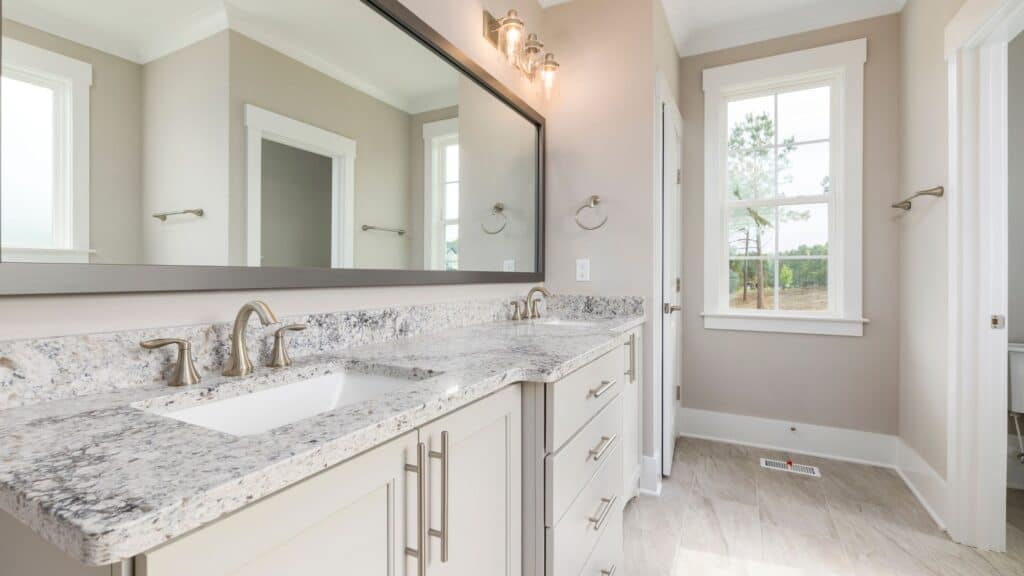Because there are so many different options available at almost every price point, choosing the best countertop for bathroom remodel can be a little bit of a challenge.
The countertop that each of us has in the bathroom supports the sink and is where we keep our daily-use accessories. It is an area that is often overlooked despite its obvious necessity. Particularly in regards to the material, it is widely believed that they are all the same and that it would be wise to save money on this purchase.
This is far from the case, as each material has unique qualities that must be taken into account before making a purchase. In this article, we will present the advantages and disadvantages of the different bathroom countertop materials readily available for your reno!
Characteristics Of Countertops For Bathroom Cabinets
It is best to concentrate on the qualities that all bathroom countertops must have before going into detail about each material we might suggest. Water and humidity resistance is crucial among all of them. The material you select for countertops with sink must be completely impervious to moisture because it will always be a wet region.
You must also pick a material that can withstand wear and tear. It is not a good idea to use fragile materials since the sink and the stone that supports it are areas that suffer daily impacts and intense use.
Consider upkeep and aesthetics next. For you to feel at ease with the stone in your bathroom and to know that maintaining it won’t be too much of a hassle, there are stones that are very simple to maintain and that do not absorb dirt in any way.
Best Countertop For Bathroom Remodel

Corastone Bathroom Countertop
The first compound that we have on the list for your bathroom countertop is Corastone. Although it initially appears to be natural stone, it is not, and has many advantages over its counterpart.
Different sediments are compacted to create Corastone, a resin-based composite with high resilience to shock and abrasion. Although having a minor flaw—it scratches easily—this is one of the most resilient materials available on the market. Since Corastone is not a natural substance, it has a very wide color range and is typically presented on matt surfaces that are attractive. This provides designers with a lot of creative freedom.
Porcelain Vs Quartz Countertops
Ceramic And Porcelain Tiles
It is not surprising that porcelain is one of the most popular building materials for large and small bathrooms. The best resistance to shock, heat, and water is ensured by selecting a countertop made of this material.
Because porcelain is non-porous, stains cannot penetrate the surface and become embedded. It also features one of the most elegant visual finishes—typically glossy.
But, ceramics aren’t as versatile as other materials in terms of shape, as their production process prevents the countertop from being given a specific shape.
You may also be interested in checking out the tile layout calculator.
Are Quartz Countertops Good For Bathrooms?
Quartz should pique your attention if you’re looking for a high-end product. Without a doubt, this is a great option if you are wondering what is the most durable material. In fact, the businesses that produce it frequently offer a lifetime warranty on their products.
Quartz countertops are resistant to impact, heat, water, and normal humidity for this area of your home. All of this is attributable to the quartz manufacturing process, which involves combining crushed natural stone with resins to produce a material that is incredibly wear-resistant.
Despite all of these benefits, Quartz does have a few disadvantages. The first is the cost, as installing a new quartz bathroom countertop can be an expensive endeavor.
Additionally, you must keep in mind that it is challenging for quartz to completely resemble a natural stone. So if this style is what you’re after, it is preferable to use another material.
Natural Stone Bathroom Countertops
Since resinous compounds were introduced later, natural stone has been the most popular option for bathrooms around the world. We’re talking about substances like quartzite, granite, and marble – all of which have exceptional qualities.
To begin with, you are dealing with countertops that are very durable and can last a lifetime. Natural stone is an inexpensive option. Although marble is somewhat more expensive, the truth is that other materials such as granite counters can help you cut costs on your bathroom countertop renovation.
Of course, keep in mind that the stone can be vulnerable to very acidic substances that penetrate its interior, so you must constantly exercise caution.
Appearances might be another factor to take into consideration. Due to the inherent veining in the slabs, each piece is unique. As a result, we advise you to view the countertop you intend to purchase in person because there might be significant variations among pieces made of the same material.
Laminate Countertop For Vanity Unit
From the vivid hues and obvious seams that many of us remember from the 1960s and 1970s, laminate has advanced significantly. This easy-care product, often known as Formica, is made of a thin plastic surface that is pressure-bonded to a particle board or plywood foundation.
Modern laminates can be printed with incredibly lifelike stone and finish for wood countertops, as well as a wide variety of solid and graphic patterns, using the most recent printing technologies.
Undoubtedly, one of the least expensive countertop surfaces is laminate. It is strong, impervious to moisture, simple to maintain, and installs rather quickly. However, laminate tends to thin or dull over time, and the damages aren’t so easy to repair. The entire counter typically needs to be replaced.
Concrete Bathroom Countertops
Concrete is no longer just used for construction; it possesses extraordinary shape-shifting properties that enable an infinite variety of appearances. For the best possible quality control, the majority of concrete countertops are produced off-site.
They can mimic the appearance of natural stone and are an organic substance with a wide variety of unique colors, textures, and decorative inlays. Concrete may be sculpted into the required size, shape, and edge design.
On the other hand, concrete is naturally porous, so countertops need to be waxed and sealed regularly. Visible seam lines are also quite common with concrete countertops, although their appearance may be minimized with a colored filler.
The factors listed above should, in summary, be taken into account when selecting a new bathroom countertop. As you can see, each has advantages and disadvantages. Therefore, carefully consider your options to determine which is the best bathroom countertop material for you
